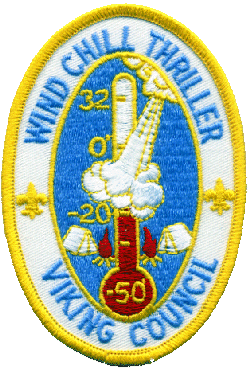Windchill Thriller*
 Note: This award being phased out 1/1/2001 although some units are still running variations of the program at a Unit level Requirements-Overnight Camping 1. Applicants must present themselves properly outfitted for winter camping. 2. Each applicant must have five nights of non-winter camping experience; This item is waved if the applicant is participating in the BSA OKPIC High Adventure program or equivalent program that provides appropriate clothing and equipment. 3. Each applicant must show an understanding of the C.O.L.D. formula explained in the BSA Fieldbook and OKPIC guidebook. 4, Each applicant must show an understanding of the symptoms and treatment for hypothermia, frostbite, and other cold related injuries or conditions. 5. Each applicant must sleep in a tent, an igloo, a quinzie, a thermal shelter, or other low impact winter shelter. 6. Wind-chill factor is a combination of temperature and wind velocity. For accumulation of minus wind-chill degrees as calculated from the U. S. Army wind-chill chart or Fieldbook for a total of -50 ° degrees, count only minus degrees. Use lowest factor during a 24-hour period from 12 midnight to 12 midnight.Example: 5 nights at -10 ° degrees wind chill = -50° degrees wind chill7. Temperature and wind velocity (wind chill) must be verified by local radio station, television station, camp ranger, or Minnesota Department of Environmental Records. 8. As wind-chill degrees are accumulated, -100 ° degrees , -150° degrees or -200° degrees segments maintained and sewn onto thermometer bulb.9. For accumulated wind chills below -200 ° degrees, either order a second patch or sew additional segments on the patch beside the thermometer bulb.10. Scout applicants must have earned camping merit badge to obtain -200 ° degrees and lower.11. Remember, open flames including liquid fuel stoves and lanterns in a tent are unsafe and in violation of BSA policy. No heating equipment is allowed in any shelter. |
|
||||||
Last Update May 15, 2023

.jpg)
